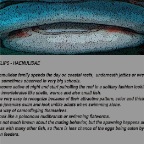Sweetlips - Haemulidae
SWEETLIPS - HAEMULIDAE
The Haemulidae family spends the day on coastal reefs, or underneath jetties or wrecks and are sometimes observed in very big schools. They become active at night and start patrolling the reef in a solitary fashion looking for benthic invertebrates like shells and worms and also small fish. They are very easy to recognize because of their attractive pattern, color and thick lips. Sweetlip juveniles swim and look unlike adults when swimming alone. This is a way of camouflaging themselves. Some look like a poisonous nudibranch or swimming flatworms. There is not much known about the mating behavior, but the spawning happens around sunset as with many other fish, so there is less chance of the eggs being eaten by plankton feeders. Length: 84 cm.Distribution: Seyshelles to French Polynesia, S- Japan and Great Barrier Reef.Adults have a white-grey colour with small dots(exept the belly), juveniles (photo)are black with white blotches. Juveniles in shallow lagoons or protected reefs, adults usually under coral heads or in caves of clear lagoons and seaward reefsfrom 3 to 50 m. Length: 50 cm.Distribution: from Bali to Philippines and W- Australia.Bright yellow with black-edged pale blue to white stripes. Juveniles similar to adultsbut less stripes. During the day solitary under ledges or resting in small groups. On coastal and seaward reefs, from 5 to 20 m.Feeds on small invertebrates during night time. Length: 85 cm.Distribution: from E- Africa to S.W- Japan, Samoa and New Caledonia.Adults are white with broad black horizontal stripes, yellow fins with black spots.Juveniles dark brown with white to cream bands or blotches, which change into black stripes. Usually solitary, but occasionally in small groups. Juveniles in clear shallow sheltered areas, adults on sheltered reefs and sand slopes, from -2 to -25 m. Length: 48 cm.Distribution: Indonesia and Philippines to SW- Japan, New Caledonia and G.B.R.White body with black diagonal lines and white belly. Yellowish snout and forehead,Pelvic- and pectoral fins yellow with bright red base. Dorsal, tail- and anal fin yellow with black spots. Lives solitary or in small groups, in lagoons, coastal and seawardreefs to -35 m. Length: 100 cm.Distribution: Red Sea & E- Africa to S.W- Japan, Fiji and Australia.Adults are dark grey with black areas on the fins and a broad dark band behind the pectoral fins. Juveniles orange with two broad black horizontal stripes, one mid-laterally and one on the upper-back. Adults mainly live solitary, but often seen in pairs.Lagoons and seaward reefs, from -2 to -50 m. Juveniles in shallow coastal waters. Length: 72 cm.Distribution: from the Maldives, Mauritius to Fiji Is., Ryukyus and New Caledonia.A yellow-gold underground with a brown leopard pattern, brown belly. Adults in coral-rich areas of clear lagoon and seaward reefs, from 1 to 30 m.During the day solitary near or under ledges and caves. Juveniles among corals of sheltered coastal and inner lagoon reefs. Feeds at night on dwelling invertebrates. Length: 60 cm.Distribution: Red Sea and E- Africa to SW- Japan, Papua New Guinea and W- Australia.Grey with numerous yellow-orange spots head and often black spots on tail- anddorsal fin. Spots on the head can fuse to oblique stripes with age.Juveniles are striped (photograph right-bottom) and stay around weedy areas. Adults on sheltered coastal reefs and lagoons below -4 m. Length: 100 cm.Distribution: Red Sea & E- Africa to SW- Japan, Fiji, New Caledonia and Australia.Adult specimen are silvery-grey, with or without dark spots. Juveniles yellow or whitewith broad dark-brown to black stripes (photograph). Feeds on benthic invertebrates and small fishes. Muddy or silty substrate of protected bays or estuaries.Juvenile move non-stop, swimming in a small depression in the sand. Length: 45 cm.Distribution: from the Red Sea to S- Africa and Mauritius.White body with black spots(not on belly) and yellow fins.During daytime under ledges or along coral slopes, mostly in pair or group.Common in clear water lagoons and seaward reefs, from 3 to -30 m.





















